By Jeffrey A. Rendall, Images Courtesy of Taylor Made Golf
It's a shame that younger generations won't be learning to play golf with persimmon woods. For those of us who did, we'll never forget the finely polished heads, the multicolored clubfaces and the 'screws' in the sweet spot, which helped coin the old saying, "putting the screws to it."
These days, if kids are to discover what the saying really means, they'll need to visit a golf museum - mainly because these newer 'big head' Titanium jobs bear little resemblance to the old wooden drivers. There aren't any screws, and the shiny metallic heads look a lot more like what Luke Skywalker or Mr. Spock would hit than the average Joe.
It's a shame only in the traditional sense, because the newer drivers are much easier to hit, and also belt the ball out there a lot farther - hence, making the game more fun. And when you're seeking this magical combination of forgiveness and distance, look no farther than the new Taylor Made R500 series. It's got the sizeable heads you'll expect from high-end modern drivers, and the performance you'll demand from a club in its price range.
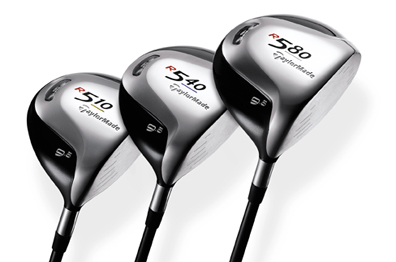 |
And considering Taylor Made introduced the incredibly well-received 300 Series drivers just two years ago, it's even more surprising to find that the company's improved on itself in such a short timeframe. Benoit Vincent, Taylor Made's Chief Technical Officer, explains: "We were extremely proud of the work we did with the 300 Series. It introduced the concept of developing a series of driver heads to match up with different players' golf games, because everyone's swing characteristics are truly unique. And after being the number one driver on the various professional tours for the past two years, the results speak for themselves."
Vincent continues, "But we also found the 300 Series didn't quite carry the concept far enough. Sure, we positioned the center of gravity (CG) farther forward in the 300 model to reduce spin and prevent the ball from ballooning in the air, and moved the CG farther back in the other models (320 and 360) to help slower swing speed golfers get the ball in the air - yet we found there were some characteristics in the clubs that could use some enhancement. We've made the transition with the R500 Series."
Having played both the Taylor Made 320 and 300 models in the past two seasons, it was a bit hard to believe there was much room for improvement. Both were quite a bit lighter than my previous driver, and the heads were large enough where I knew I'd make reasonable contact, even on my poorest swings. And the respective performances were different too - I'd hit the 320 higher and farther (under most conditions), but the 300 model had less curvature in the ball flight, allowing for more control.
Vincent wasn't surprised to hear of my different impressions of the previous products, and he said golfers will see differing results from the new line, too. "I'd say the differences in the R500 Series (R510, R540 and R580) are more drastic and distinct than the 300 Series (note: the 300 Series included the 360 model, which I haven't tried). The R510 is a true product for the high-spin, high swing speed golfer, because the club kills the spin and allows for more workability. Spin is the enemy of higher swing speeds, because it causes the ball to fly too high and come straight down after reaching the apex (a.k.a. ballooning)."
"This type of player wants a flatter trajectory, to not only fly farther, but also provide roll. In contrast, the average player, with slower swing speeds, needs spin in order to get the ball in the air. And that's what we've done with the R540 and R580, which generate spin for this type of player. It's a delicate balance, and only through personally testing the clubs will players truly get an idea of which one is right for each person," Vincent added.
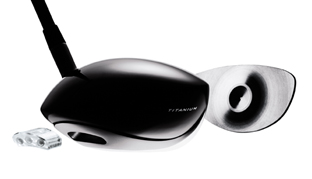 |
Maybe it was the research data that led Taylor Made to dream up the R500 Series, or maybe it was player feedback. Whatever the reason, the R500's going to produce longer shots, too. If that weren't the case, then why would folks bother buying something new?
Vincent explains how: "There's a lot of talk these days about COR (Coefficient of Restitution, or the controversial 'spring-like effect' of clubfaces) and all the rage is to use a driver that provides the maximum COR at impact. Both the 300 Series and R500 Series have the same COR of .830, but the difference being, the newer clubs give you a lot more space (on the clubface) to achieve the maximum desired effect."
Here's about where I lost him, but Vincent then put it in terms myself and the average duffer can understand: "Think of the maximum COR area on the 300 series as the tip of your little finger, or about the size of a dime. That spot's right in the middle of the clubface, and when you hit it, you're getting the full .830 COR you'll want."
"Truth is, only the best players are able to take full advantage of that benefit, because most of us aren't able to hit that small area very often. The farther you miss that 'dime' sized spot, the more distance you'll lose, because the COR decreases incrementally. You'll still get a COR of about .800, which is what you'd get from an old style driver, but you're losing the benefits the newer clubs offer," Vincent said.
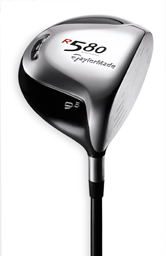 |
"So one of the things we worked on was creating a much larger area where you'll get the maximum .830 COR - and we've achieved that through the invention of inverted cone technology. It expands the area of .830 COR contact, and therefore, will increase the overall velocity of your tee shots. In other words, it'll improve your off-center hits, which helps average and good players alike," Vincent added.
And don't forget, size matters too.
"We've also increased the size of the club heads over the 300 Series, which offered 300cc, 320cc and 360cc heads. The new R500 Series heads are larger for each category. The R510 is 330cc, the R540 is 350cc and the R580 is 400cc. The larger face area provides for more confidence at address, as well as 'forgiveness,' though I don't like using that word - it basically means you'll reach the fairway more often, even with off-center hits," Vincent said.
One final component change in the new R500 Series builds in still more flexibility. Vincent explains: "Once again, we've enjoyed the amazing success of the 300 Series, but we found that even though we had different club heads, they weren't always compatible with the wide variety of shafts available today. If you want an exotic shaft, the manufacturer usually ends up trimming the shaft, which compromises the length or balance of the product."
Vincent continues, "In order to produce the desired swing weight every time, we designed a proprietary weight system whereby we can adjust the head weight to fit the individual shaft. So we developed a cartridge to insert at the back of the club, which covers 12 grams of range in the weight of the head - so you can use any shaft you want with the R500 Series club heads and still be true to the balance of the product."
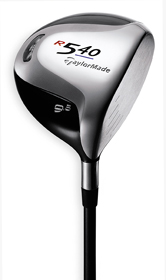 |
Sounds like genius to me. Not only does the R500 series build in the flexibility of head characteristics, you can choose the perfect shaft to use with it.
Based on my personal criteria, I tried the R540 model with a 45-inch stiff shaft. The head feels a bit heavier than the 300 series models I've used, but adds more of a solid feel. The R540's 350cc head also looks noticeably bigger than the previous clubs, and took a few minutes to get used to (hardly a big deal).
Upon using the R540 for a few rounds, I've noticed a lower, more piercing trajectory with tee shots (I haven't tried hitting it off the fairway, and can't really see using it in this manner), which certainly helps when hitting into the wind. There's also been a noticeable increase in roll, which will definitely help in drier conditions - and also on wetter days, because the ball had much less tendency to plug.
Distance-wise, it's difficult to distinguish between the R540 and the older 320 and 300 models. I'd say the lower ball flight kept the ball airborne longer, which produced a little more carry, and more distance. The flight characteristics were noticeably different in the R540, which is an improvement over my prior experiences. I have fairly high swing speeds (105-108 mph) for an average amateur player, and I've always had a tendency to hit the ball too high off the tee.
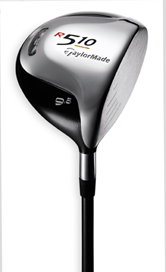 |
I think the difference in trajectory comes from having a stiffer tip on the shaft of the R540 (which Vincent confirmed), along with one degree less loft (8.5 vs. 9.5) on the new club.
To sum up, the new R500 series is the latest in the continuum of superior Taylor Made technological advances in metal woods. In buying one, you'll know you're getting the very latest in state-of-the-art technology, which is certainly necessary to keep up with the best in equipment these days. You can't go wrong by choosing one of the R500 models - but I'd also highly recommend visiting a professional club-fitter before purchasing, and so do the Taylor Made people.
Then, by all means, try the clubs on the range. You might just find, after nailing a few drives to the back of the fence, you're 'putting the screws' to the ball once again.
Details:
The Taylor Made R500 Series Drivers
Models: R510, R540 & R580
Available at fine pro shops and retail stores.
R500 Series Designer: Benoit Vincent
Check out all the outstanding products at Taylor Made's Website
Note: As indicated above, Taylor Made is the number one driver on the various world professional tours. 'Star' players include Ernie Els, Sergio Garcia and Rich Beem, amongst others. Consult the Taylor Made website for an expanded list of professional players using the products.
| Related Links | Comments on this article? | |
|
Maryland National Golf Club Hollow Creek Golf Club Rocky Gap Resort PB Dye Golf Club in Ijamsville Whiskey Creek Golf Club |
E-mail Jeff Rendall, Editor: jrendall@golftheunitedstates.com |












